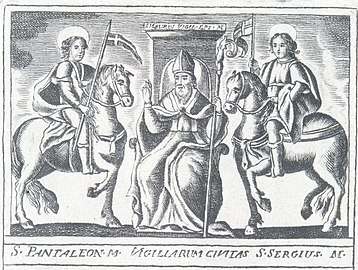Bisceglie
Bisceglie (Italian: [biʃˈʃeʎʎe]; Biscegliese: Vescégghie)[4] is a city and municipality on the Adriatic Sea of 55,251[5] inhabitants in the province of Barletta-Andria-Trani, in the Apulia region (Italian: Puglia), in southern Italy. The city was awarded Blue Flag Beach certification in 2001 for high environmental and quality standards.[6] Scallette and Salsello Beaches were also certified in 2003, 2005 and 2006.[7]
Bisceglie | |
|---|---|
| Comune di Bisceglie | |
 The harbour | |
 Coat of arms | |
Location of Bisceglie 
| |
 Bisceglie Location of Bisceglie in Italy  Bisceglie Bisceglie (Apulia) | |
| Coordinates: 41°14′35″N 16°30′19″E | |
| Country | Italy |
| Region | Apulia |
| Province | Barletta-Andria-Trani (BT) |
| Government | |
| • Mayor | Vittorio Fata |
| Area | |
| • Total | 69.25 km2 (26.74 sq mi) |
| Elevation | 16 m (52 ft) |
| Population (31 December 2017)[2] | |
| • Total | 55,385 |
| • Density | 800/km2 (2,100/sq mi) |
| Demonym(s) | Biscegliesi |
| Time zone | UTC+1 (CET) |
| • Summer (DST) | UTC+2 (CEST) |
| Postal code | 76011 |
| Dialing code | 080 |
| Patron saint | Sts. Maurus, Sergius and Pantaleon[3] |
| Saint day | First Monday in August |
| Website | Official website |
It is the municipality with the fourth highest population in the province[8] and fourteenth highest in the region.[9]
It is an important agricultural hub, with manufacturers mainly in the textile industry.

Physical Geography
Extent
The city stretches along roughly 7.5 kilometres of the Adriatic seashore between the municipalities of Trani to the north and Molfetta to the south.
The mainly flat land gradually slopes toward the sea along the shoreline, which is scored with shallow valleys with microclimates favourable to the flourishing of flora and fauna. The city extends inland toward the municipalities of Corato, Ruvo di Puglia, and Terlizzi, where it reaches the foothills of the Murge Plateau.
In height, Bisceglie ranges from sea level to 160 metres above it and mainly occupies a strip between the shore and the Bologna-Lecce railway line, with some foothills going beyond the railway line in the Sant'Andrea neighbourhood, the employment and industrial areas. The oldest part of the city, once bounded by two valleys that converge near the basin of the port, sits higher than the later surrounding urban development.
Climate
The city has a Mediterranean climate, with continental humid winters and hot, humid summers. Temperature fluctuations are moderated by the Adriatic Sea. Being a coastal city, relative humidity remains high throughout the year and ranges on average between 70% and 90%. Cold air currents from the northeast often bring lower temperatures in winter and sporadic amounts of snowfall. Rain, mainly confined to the winter months, is extremely variable.
Name
According to one theory, in Roman times there may have been a settlement here called Vigiliae ("Vigil"). The name in the local dialect, Vescégghie, and similarly, Bisceglie, could be variants arising from that original name. The name could be for a settlement or simply from a series of lookout checkpoints for "vigilant" sentinels who would keep watch from guard posts along the Via Traiana there for pirates.[10]
Another related theory is that the word Viscile or Vescegghie in the local dialect came from a more ancient word for an abundant local type of oak tree, the visciju (Quercus calliprinos). The oak is the oak of Palestine, which grows both as a tree and as a shrub. In Italy, it only grows in Apulia, Basilicata and Sicily.[11] In addition, since it was the custom of the Romans to donate an oak branch to those who had saved human life, Bisceglie, which kept watch over entire cities with constant vigilance ... would have had an oak tree as a gift.[12]
History
Overview
According to one theory, in Roman times there would have been a settlement here called Vigiliae ("Vigil"). The modern city was founded by the Normans in the 11th century and enlarged under the Aragonese dynasty of Naples in the 15th century.
Prehistoric Period
The territory of Bisceglie has been inhabited since prehistoric times.
In the Paleolithic period caves in the area were inhabited by people of Mediterranean descent. Evidence of human activity is found in numerous flaked stone weapons and tools, remains of animals of extinct species such as prehistoric lions, bears, oxen and horses, remains of animals of remote species like rhinoceros, hyena, and deer, and the curved human femur typical of Neanderthal man found in the grotto of Santa Croce that is currently preserved in the National Archaeological Museum of Taranto.
In the Zembro[13] cave, ceramic remains from the Neolithic period have also been found.
In the Bronze Age, impressive grave-altars called dolmens were built on Bisceglie land by the primitive people who lived there. The most interesting in quality are the Chianca dolmen (from the local dialect word 'chienghe', or stone slab), the Albarosa dolmen, and the Frisari dolmen.
Greco-Roman Period
When the central part of Puglia was supposedly occupied by the Peucetians, a theory not supported by sufficient archaeological evidence, the area of the prehistoric sunken Karst basin that forms a wide natural amphitheature in Molfetta, and the district of Navarino in the territory of Bisceglie, were both home to Greek settlers who had left their native lands of Pylos and Nabàrinon in Greece, from which local place names (toponyms) would derive.[14] In the third century following the Pyrrhic War, the territory fell under the dominion of Rome, and even though furrowed by new roads, it continued to be a transit zone and a place of scant importance.[15] You will note that a Roman-era milestone can be found in the garden at Piazza Vittorio Emanuele II near Route SS16.
High Middle Ages
At the fall of the Western Roman Empire, the territory of Bisceglie was characterized by the presence of small clumps of houses surrounded by high walls that were often adjacent to religious temples. The Giano (Janus) farmhouse dating back to the Roman age, and the hamlets of Cirignano, Pacciano, Sagina, and Zappino are all known for this type of house.
From the early years of the seventh century up to 800 the territory of Bisceglie remained under the governance of the Lombard gastald of Canosa.
Around 700 the Janus farmhouse, an ancient place of pagan worship, became the seat of a rich monastery, while in 789 some houses of the Pacciano hamlet were sold to the famous monastery of Santa Sofia. There was a spot there along the coast, rough and dense with vegetation, that was a good shelter for boats that was called by the inhabitants Vescègghie, from the name of the wild oaks spread all around. That spot was a natural outlet to the sea for those peasants who slowly started a modest seafaring collective. From that arose a small fishing village called Vescègghie, in the same timeframe as the establishment of other villages of Lombard origin such as Giovinazzo on the Adriatic coast and Terlizzi, inland. From 800 the territory was subject to the Longobard Gastald of Trani, in that period a flourishing Adriatic city. Subsequently, for about thirty years, the land of Bari was held by the Saracens, then passed to the Lombards and the Byzantines.
The Norman-Hohenstaufen and Capetian House of Anjou Periods
Around the year 1000 the Normans landed on the Adriatic coast. In 1042 Robert Guiscard assigned Trani and its surroundings to his vassal Peter I of Trani, who became Count of Trani and retained that title until 1060. He, following some homeowners' requests for protection, started fortifying an area of homes that had cropped up near the sea. In 1060 the most ancient core of the city, surrounded by walls, was equipped with an imposing watchtower called the main tower.
In this period the worship of Saints Maurus, Sergius and Pantalemon was introduced and they became the new patron saints of Bisceglie. In 1063 the bishopric of Bisceglie was established by Pope Alexander II and the construction of the cathedral was started.
In 1071 Robert Guiscard reassigned Bisceglie to Peter II, Count of Trani.
In 1167 Bishop Amando ordered the transportation of the sacred relics, kept until then in a sepulcher in the hamlet of Sagina, to within the city walls where the cathedral building had been completed. Among the varied activities of the nascent urban settlement, seafaring activity was key for profitable trade with the Dalmatian and Albanian coast, as well as with the Aegean Islands and the island of Cyprus.[16]
Subsequently, Frederick II, Holy Roman Emperor ordered the construction of a castle adjoining the main tower.
Furthermore, the Hohenstaufen built up the entire territory with watchtowers. Some surviving examples can be found in the Gavetino tower, the tower of Sant'Antonio and the Zappino tower. Under the Capetian House of Anjou Bisceglie entered the fiefdom of the Counts of Montfort. In 1324 it passed to Amelio del Balzo and later, in 1326, to Robert of Anjou, son of King Charles II of Naples and his brother Philip. Despite the period of thriving commerce with the ports of the Adriatic and beyond, the young city was at the heart of intricate and bloody struggles that tore Puglia apart under Joanna I of Naples.
In 1360 James of Baux became Count of Bisceglie. In the period between 1381 and 1405 he was Count of Bisceglie Raimondo Del Balzo Orsini.
In September 1384 the pretender to the throne Louis I, Duke of Anjou, brother of King Charles V of France, and Charles III of Naples clashed with a long guerrilla war and on the night of 13 September Naples' forces breached the walls and sacked Bisceglie. On this occasion, Louis I, Duke of Anjou was wounded and died a few days later, on 20 September.
From 1405 to 1414, King Ladislaus I of Naples held the county, and entrusted it to Lorenzo Cotignola as a reward for meritorious military service. During this period, Queen Joanna I of Naples granted some privileges to Bisceglie, including the appointment to arm galleys in her arsenal.
Lucrezia Borgia, Duchess of Bisceglie

On 21 July 1498 Lucrezia Borgia married Alfonso of Aragon, duke of Bisceglie and prince of Salerno, illegitimate son of Alfonso II of Naples, whose nickname was "most beautiful boy".
The marriage would be a short one for Lucrezia, just as her previous ones, and would end tragically for the man she loved.
Cesare Borgia, Lucrezia's brother, refused by Charlotte of Naples, married Charlotte of Albret instead, thereby becoming a cousin of the king of France. He pledged to help the monarch regain the kingdom of Naples. All this Gallicism alarmed Alfonso who sought refuge with his family, abandoning a pregnant Lucrezia and leaving her with a broken heart. At that point, the Pope entrusted her with the post of Governor of Spoleto to raise her spirits.
On 19 September 1499, Alfonso, pushed by his uncle Frederick Ⅳ who did not want to displease the pope, reunited with Lucrezia and together they returned to Rome. In November, the duchess of Bisceglie gave birth to a boy named Rodrigo.
On 15 July 1500 Alfonso was seriously injured in an ambush. The ambush was sprung by Cesare, probably eager to eliminate his Spanish kinship. Despite the severity of the wounds Alfonso healed, to Lucrezia's great joy. Cesare, unhappy with how things went, would say, "What has not been done at lunch, can be done very well at dinner.".[17] Alfonso was killed by Cesare's assassin, one Micheletto Corella, on 18 August 1500 in Lucrezia's room when she had been called away on some pretext. The official explanation is that the Duke of Bisceglie broke his head open following a terrible fall while he was still convalescing. The duchy was placed in the hands of little Rodrigo accompanied by a guardian, while his mother became governor of Nepi, and would soon become Duchess of Ferrara.[18]
Ecclesiastical history
Around 800 AD, the Diocese of Bisceglie was established.
It was suppressed on 27 June 1818, its territory and title being merged into the Metropolitan Archdiocese of Trani-Bisceglie.[19][20]
Veneration of the three patron saints

According to the tradition reported by Armando, bishop of Bisceglie, in the time of Emperor Trajan two noble Roman knights, Sergius and Pantalemon, were won over by the words of Maurus of Bethlehem, a bishop preaching Christianity. Having converted to the new faith, the three were arrested and sentenced to death on 27 July 117. After their martyrdom, their remains were transported to the Bisceglie area in the Sagina district, where a Christian widow, Tecla de Fabiis, placed them in a tomb that she had had built. Slowly the worship of the three patron saints began to spread in the newly-formed maritime village of Bisceglie. On 9 June 1167, under the bishop Amando, the sacred relics of the three martyrs were transported inside the walls of Bisceglie, and initially kept in the church of San Fortunato, near the castle. Later the bones were transported to the church of San Bartolomeo and, finally, on 30 July 1167 they were transported to the cathedral of Bisceglie. Here, they were placed in three stone urns under three altars, in a specially constructed crypt.[21]
Main sights
- Cathedral (13th century)
- Church of Santa Margherita, in Romanesque-Apulian style (12th century), with fine canopied tombs of the Falcone family[22]
- Hohestaufe-Angevin castle and Norman tower
- Abbey of S. Adoeno (11th century)
- grottoes of Santa Croce
- 4 dolmens
Also notable is the naturalistic area of Pantano-Ripalta.
Twin towns — sister cities
Bisceglie is twinned with :





People
- Louis I, Duke of Anjou died there in 1384
- Cesare Fracanzano (1605–51) tenebrist painter
- Gaetano Veneziano (1665–1716) baroque composer
- Mauro Giuliani (1781–1829) guitar virtuoso and composer
- Leonardo de Mango (1843–1930) orientalist painter
- Mauro Cozzoli (1946), theologian and writer
- Erica Mou (1990) pop-singer and musician
- Nancy Dell'Olio (1961) lawyer
Transport
Bisceglie railway station links it with cities such as Rome, Bologna, Ancona, Foggia, Bari, Lecce and Taranto.
Sources and external links
Notes
- "Superficie di Comuni Province e Regioni italiane al 9 ottobre 2011". Istat. Retrieved 16 March 2019.
- https://ugeo.urbistat.com/AdminStat/en/it/demografia/dati-sintesi/bisceglie/110003/4
- Source for patrons: http://www.comuni-italiani.it/072/009/index.html
- Various authors. Dizionario di toponomastica. Storia e significato dei nomi geografici italiani. 1996. p. 80. Milan: GARZANTI
- TuttiItalia. "Popolazione Bisceglie 2001-2018". TuttiItalia. 2019 Gwind srl. Retrieved 10 October 2019.
- "Bandiera Blu 2001" Retrieved 6 April 2015
- Retrieved 6 April 2015
- "dati del bilancio demografico ufficiale ISTAT" Retrieved 11 September 2014
- "dati del bilancio demografico ufficiale ISTAT" Retrieved 9 November 2011
- "Pompeo Sarnelli theorized that Bisceglie was founded by the Romans at the time of the Pyrrhic war. In the service of Rome, the countryside would have carried out the task of supervising the sea through checkpoints, from whence the name Vigiliae, and subsequently Bisceglie. In addition, since it was the custom of the Romans to donate an oak branch to those who had saved human life, Bisceglie, which kept watch over entire cities with constant vigilance ... would have had an oak tree as a gift. ", Mario Cosmai, THE STORY OF BISCEGLIE, 1960", Mario Cosmai, LA STORIA DI BISCEGLIE, 1960
- cfr. the thesis supported by prof. Alberto Simone, exposed in the article THE BISCEGLIE NAME AND ITS ORIGIN, published in the Collection of the Historical Review of Municipalities, p. 110 ff., Vol. 3, 1971 edited by the Atelliani Study Institute, and the thesis of prof. Mario Cosmai presented in his book THE HISTORY OF BISCEGLIE, pag. 20 ff., Published in 1960 by Il Palazzuolo.
- "Pompeo Sarnelli theorized that Bisceglie was founded by the Romans at the time of the Pyrrhic war. In the service of Rome, the countryside would have carried out the task of supervising the sea through checkpoints, from whence the name Vigiliae, and subsequently Bisceglie. In addition, since it was the custom of the Romans to donate an oak branch to those who had saved human life, Bisceglie, which kept watch over entire cities with constant vigilance ... would have had an oak tree as a gift. ", Mario Cosmai, THE STORY OF BISCEGLIE, 1960", Mario Cosmai, LA STORIA DI BISCEGLIE, 1960
- toponym derived from dialect term "zembre", which means beak
- Read 'Memories of Bishops of Bisceglia' by Pompeo Sarnelli, published in Naples in the early seventeenth century, and the observations made by Mario Cosmai in the first chapter of the book 'History of Bisceglie', published in Bisceglie in 1960
- "In light of historical evidence, there are no traces that reveal the existence of a Roman city on the coastal stretch between Trani and Molfetta, despite traces of Greeks and Romans in the Biscegliese Territory. There is mention of Giano on a map from 700 and Paciano on a map from 790. The first document explicitly mentioning the Vigiliae site dates back only to the end of the 19th century." Mario Cosmai, History of Bisceglie, p. 19, Bisceglie, 1960
- In a 1211 charter, mention is made of a commercial agreement between Bisceglie and Ragusa Dalmata. Mario Cosmai, History of Bisceglie, p. 30
- Quote not supported by sufficient evidence
- Ideas and thoughts on the story can be found in "Private Renaissance" by Maria Bellonci, published by Rizzoli.
- "Diocese of Bisceglie"Catholic-Hierarchy.org. David M. Cheney. Retrieved October 7, 2016
- "Diocese of Bisceglie" GCatholic.org. Gabriel Chow. Retrieved October 7, 2016
- This is what is reported in the religious tradition. For further information read Mario Cosmai in HISTORY OF BISCEGLIE, p. 33, ed. Mezzina, 1960.
- Chisholm, Hugh, ed. (1911). . Encyclopædia Britannica. 3 (11th ed.). Cambridge University Press. p. 992.
